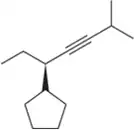Given the name, draw the structure of the following compounds.
(b) (4Z,8R)-8-bromo-5-methylnon-4-ene

 Verified step by step guidance
Verified step by step guidance Verified video answer for a similar problem:
Verified video answer for a similar problem:



 1:48m
1:48mMaster Why stereoisomers need their own naming system. with a bite sized video explanation from Johnny
Start learning